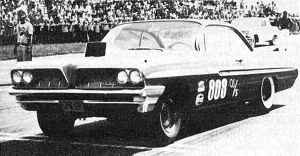|
It was too late to do anything about the '56s, but he swung into action for the 1957 model year. Another enlargement of the V-8, now out to 347 cubic inches, brought with it more power. The dual quad option was dropped. The hot assembly line setup for '57 was a new, triple 2-barrel carburetion option that upped the rating of the hottest regular production option to 290 horsepower. There were more special racing options for '57 too, under Knudsen, who believed in racing as a way to build a youthful, performance-oriented image. A hot camshaft with solid lifters, higher 10-to-one compression ratio and other goodies coaxed 317 horsepower at 5200 rpm out of the engine.
Pontiac swept house at Daytona in 1957. Their rocketship-sided cars averaged 136 mph over the sand course with John Zink driving. Cotten Owens won the Grand National race. Both triumphs came over a factory team of Chrysler 300s: the hottest road cars out of Detroit, at the time.
The year '57 was significant for a few reasons other than the racing victories. The fact that Pontiac offered one high performance option to the general public and held back the hottest special racing parts for over-the-counter, dealer installation set a policy which many of the other companies later followed. By keeping the hottest racing stuff for over-the-counter sales and dealer installation, you eliminate the assembly line slow-ups that occur when special equipment is installed. You also eliminate special service problems at the dealership level. Other factories copied this plan for many years.
 |

At top is a Stiles Performance-prepared, Stahl-headered '65 GTO that really tore 'em up in the then-hairy A/FX class. This car is lettered with the top names in the York (Hellam, Wrightsville), Penna. area. The '61 Pontiac Optional S/S tore up the '61 Nationals. Check that wild hood scoop—or gaping hole! If this car were to appear today it would surely blow minds and confuse (although only momentarily, for he has a computerized mind) farmer Dismuke.
 |
|

Rochester engineers had offered their fuel injection setup for use by other GM divisions early in 1957. Chevrolet quickly snapped it up for use on the Corvette. Knudsen was all for offering the fuel injection setup as an option across the board, but Pete Estes, then Pontiac chief engineer, vetoed that plan. He felt that there would be too many service headaches because dealership personnel were still inexperienced in most high performance work. Finally, Knudsen and Estes decided to build 1500 special fuel injected cars. The new model was called the Bonneville. All 1500 were convertibles and featured real leather seats and other luxury appointments in addition to the fuel injection setup. Needless to say, these '57, Bonneville convertibles are collector's items today.
As a publicity gimmick, one of these Bonneville convertibles was outfitted with a set of leather bucket seats and was shown around during Daytona Speed Weeks in 1957. This was the first time bucket seats were ever seen in a full-size American car. They were an immediate sensation. Knudsen ordered buckets as standard in all '58 Bonnevilles. But the production people didn't know how to build them in quantity and the buckets were reduced to an option. Still, many '58 Bonneville buyers specified the bucket seats and this is how we came to have bucket seats in large cars!
Nineteen-fifty-eight saw the expansion of the high performance Bonneville lineup into a 2-door hardtop as well as the convertible. The styling was kind of funky, even for '58, but Pontiac stylists felt that rocketships on the sides of cars were the hot setup then.
The tripower street option was continued on the new, larger 370-cubic-inch block and rated 300 horsepower at 4600 rpm. This was with 10.50 compression ratio and a hot hydraulic camshaft. The four-barrel version of this engine was rated 285 horsepower at 4600. There was also a fuel injection option listed for the street engine. The fuelie rated 310 horsepower at 4800 rpm, but according to Pontiac sales records, no '58 fuel injection engines were actually built.
NEXT >
|